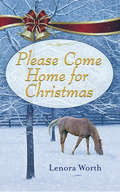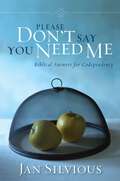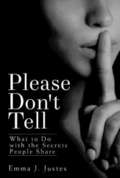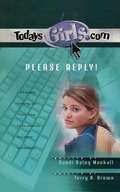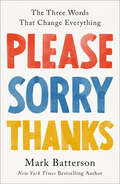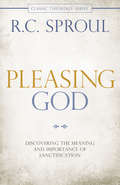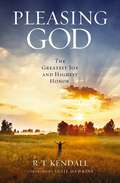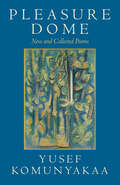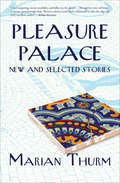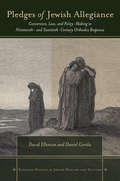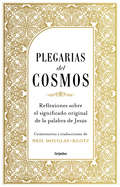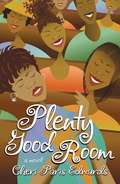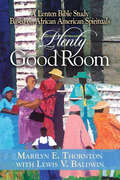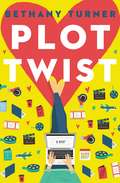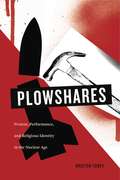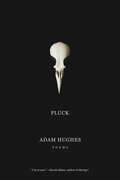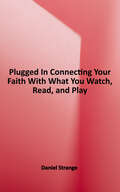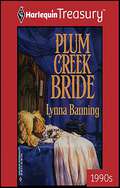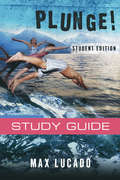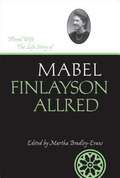- Table View
- List View
Pleasant Hill and Its Shakers
by Thomas D. Clark F. Gerald HamFROM THE BACK COVER The Shakers at Pleasant Hill had a vital impact for more than six decades on the development of Kentucky. Settling in Central Kentucky in 1805 to establish a religious communal village, they brought a standard of excellence and innovativeness that reached far beyond their group. nces and services: exhibition tour, museum, river cruise, overnight accommodations, dining, and craft sales shop. This book's author, Dr. Thomas D. Clark, has been intimately associated with the Shaker Village of Pleasant Hill restoration efforts from the beginning and has watched the progress with keen interest. He narrates the story of these fascinating people with knowledge, warmth, humor, and dramatic animation. Few outdoor history museums have been blessed with having a noted historian and writer of Dr. Clark's caliber on the scene to recount their history
Please Come Home for Christmas: A Novella (Sleigh Bells Ring)
by Lenora WorthIn the air there’s a feeling of Christmas . . . and something fishy.Her heart ought to be on the naughty list. Amy has hardly shown her son around the family horse farm or brushed a thoroughbred before she’s fraternizing with the enemy. It’s been awhile since her husband died, since her heart felt this way.But after real estate developer Dan Wentworth has been so cozy with her sisters about selling their newly inherited property, Amy can’t be sure if he’s warming up to her. Or merely warming her up to the idea of letting the family homestead be bulldozed for a housing development.She doesn’t want to hurt her sisters, but the money from Dan’s proposal could go a long way in making single-motherhood merry and bright.
Please Don't Say You Need Me: Biblical Answers for Codependency
by Jan SilviousPlease Don’t Say You Need Me . . . is a common plea voiced by people trapped in unhealthy, codependent relationships. Confused by their conflicting emotions, they feel trapped between wanting to love and care for someone else and yet, at the same time, needing to escape from that person’s intense and suffocating demands for self-esteem. Jan Silvious offers practical, biblical answers for those dealing with codependency—actually, people-dependency—that can exist between mates, siblings, parents and children, and friends. · Who is the codependent person? · What is a codependent relationship? · What role does guilt play in a codependent relationship? · Can Christians be codependent? Jan Silvious answers these questions and shows readers how to identify and break the cycle of a codependent relationship in a loving, scriptural manner. Here is insight, hope, and encouragement for replacing unhealthy ways of relating with a new approach that can bring balance and wholeness.
Please Don't Tell: What to Do with the Secrets People Share
by Emma J. Justes"I’ve never told a soul, and you have to promise not to tell anybody." "Pastor, I wanted you to know before we tell the kids, just in case they come to you." "I’m so happy. Yes, finally, I’m pregnant. I just had to tell someone." "Yes, it's terrible, but am I going to explain it to our friends here at church?"People need trusted persons as sounding boards and confidants. Not many weeks go by that someone does not confide a secret to a church leader, whether pastor, youth director, church secretary, choir director, or board member. While pastors have a unique role when it comes to confidentiality, listening to secrets is something that every church leader does. But there are both privileges and responsibilities in reporting, discerning the truth, and helping people bear the deep sins or temper the anger that threatens to overflow.
Please Help Me, God (Letters From Covenant House)
by Sr. Mary Rose McGeadyThey are the children no one knows, nameless and faceless shadows that walk our streets, desperate and scared and alone. They are America's street children, and they are more than 1,000,000 strong. Entangled in a web of abuse and sex, these innocent kids--some as young as ten--struggle to find hope in a dark world few of us will ever know about, and none of us will ever see. Who exactly are these kids? How do they end up on our streets? Where do they come from? How do they manage to survive? Do they survive? This is their incredible story, told from the alleyways and dead-end streets of America. It's a story you will never, ever forget...." The last few chapters of the book offer valuable information. However, because the copyright date is 1997, this information might be outdated.
Please Reply!
by Dandi Daley MackallAs fifteen-year-old Jamie becomes involved in the swim team and Special Olympics coaching, as part of her effort to fit in and be normal, she tries to remember to talk to God.
Please, Sorry, Thanks: The Three Words That Change Everything
by Mark BattersonStrengthen your spiritual, mental, and emotional health and reach your most audacious goals with three simple but power-packed words—from the New York Times bestselling author of Win the Day.&“A practical framework to be the kind of thoughtful, helpful force for good you always wanted to be.&”—Carey Nieuwhof, founder of the Art of Leadership AcademyThe best predictor of success in life, in love, and in leadership is your proficiency at please, sorry, and thanks. Those three words are the foundation of all healthy relationships and successful careers. Those three words are the only ceiling on achieving your dreams. Those three words will determine how happy you are.With his trademark blend of personal stories, scientific and historical references, and biblical insight, Pastor Mark Batterson shows how you can change your world with your words:• A timely please can help you unlock the rule of reciprocity for greater results, discover the power of &“we is greater than me,&” and honor others above yourself.• A sincere sorry can lead you to mend broken relationships, strengthen connections through being radically vulnerable, and better understand the degrees of forgiveness.• A heartfelt thanks paves the way toward a resilient mindset of gratitude and an expectancy to see God move on your behalf.Whether you&’re launching out into a new phase of life or navigating long-established complexities, it's time to harness the power of those three transformative words and let them propel you wherever God leads you to go.
Pleasing God
by R. C. SproulDr. R.C. Sproul is one of the most vital and renowned theologians of our time. For over 40 years Dr. Sproul has encouraged, educated, and enlightened millions through his books, teaching, and ministry. How can imperfect people hope to please a perfect God? The answer is both simple and challenging: sanctification. Pleasing God takes an in-depth look at sanctification and its essential role in the life of every believer. Filled with Biblical insights, this release guides both new and seasoned Christians through God's path for transforming His people.
Pleasing God: The Greatest Joy and Highest Honor
by R.T. KendallPleasing God is a practical resource for Christian living that inspires believers to seek the greatest honor of anyone's lifetime--to have the privilege of pleasing God.Christ's total forgiveness means that we do not have to earn our salvation. When we give our lives to Jesus, we are justified by faith alone. Good works are not required. Prayer is not required. Practicing total forgiveness is not required. Wow--what a gift! But chances are, if you have been born again you want to do good works. You want to pray. You want to forgive and love your enemies. You desire to please God.In Pleasing God, bestselling author and well-known preacher, R.T. Kendall, unfolds the meaning of persistent faith. Starting with the story of Enoch, Dr. Kendall explores biblical teachings that call believers to "find out what pleases the Lord" (Ephesians 5:10).With biblical teaching, personal stories, and humble wisdom, Dr. Kendall answers these questions:What pleases God (and what displeases Him)?Why should we please God?How should we please God?Imagine the joy and peace that will come from pleasing God more than seeking approval from others. The world needs this book!
Pleasure Dome: New and Collected Poems (Wesleyan Poetry Series)
by Yusef KomunyakaaYusef Komunyakaa has become one of America's most compelling poets. Pleasure Dome gathers over twenty-five years of work, including early uncollected poems and a rich selection of new poems. Best known for Neon Vernacular, which won the Pulitzer Prize for Poetry in 1994, and for Dien Cai Dau, a collection of poems chronicling his experiences as a journalist in Vietnam, Yusef Komunyakaa has become one of America's most compelling poets. Pleasure Dome gathers the poems in these two distinguished books and five others—over two and a half decades of Komunyakaa's work. In addition, Pleasure Dome includes 25 early, uncollected poems and a rich selection of 18 new poems.
Pleasure Palace: New and Selected Stories
by Marian ThurmShort fiction filled with both warmth and dark wit by a writer who &“embraces the ironies and the absurdities of the ordinary world&” (Newsday). At the age of twenty-five, Marian Thurm began publishing short stories in the New Yorker, and over a remarkable career, her work has been compared to the short fiction of Lorrie Moore, Ann Beattie, and Amy Bloom. Known for her uncanny sense of the absurd along with her empathy for her characters, Thurm&’s acclaimed writing has been featured in The Best American Short Stories, as well as numerous other anthologies. This volume, selected from her four collections—with stories written over a span of forty-two years—shows Thurm&’s remarkable craft, never failing to reveal both her emotional acuity and her pitch-dark humor. &“Marian Thurm is either a movingly compassionate observer of human foibles or a charmingly ruthless one.&” —The New York Times Book Review
Pleasures of God
by John PiperThe author, a pastor, discusses chapter by chapter the pleasures of God, from His pleasure in His Glory to His pleasure in the prayers of His people.
Pledges of Jewish Allegiance
by Daniel Gordis David EllensonSince the late 1700s, when the Jewish community ceased to be a semiautonomous political unit in Western Europe and the United States and individual Jews became integrated—culturally, socially, and politically—into broader society, questions surrounding Jewish status and identity have occupied a prominent and contentious place in Jewish legal discourse. This book examines a wide array of legal opinions written by nineteenth- and twentieth-century orthodox rabbis in Europe, the United States, and Israel. It argues that these rabbis' divergent positions—based on the same legal precedents—demonstrate that they were doing more than delivering legal opinions. Instead, they were crafting public policy for Jewish society in response to Jews' social and political interactions as equals with the non-Jewish persons in whose midst they dwelled. Pledges of Jewish Allegiance prefaces its analysis of modern opinions with a discussion of the classical Jewish sources upon which they draw.
Plegarias del cosmos: Reflexiones sobre el significado original de la palabra de Jesús
by Neil Douglas-Klotz«Cuidado, lector: aunque este libro es breve, contiene las semillas de una revolución.» Matthew Fox, director fundador del Institute of Culture and Creation Spirituality Neil Douglas-Klotz, el sufí fundador de la red internacional de las Danzas de Paz Universal, nos regala una nueva interpretación de las palabras de Jesús a partir de su idioma original: el arameo. Descifrándolas con base en esa antigua realidad, Plegarias del Cosmos recorre las oraciones y las bienaventuranzas del misticismo del antiguo Medio Oriente, horadando su significado, además de que nos deja ver a un Cristo más místico, feminista, cósmico; leerlo es como tener la contraseña secreta a una verdad oculta a plena vista. Es un libro que nos permite experimentar las Escrituras a través del corazón, del cuerpo y de la meditación. Toda una revelación espiritual. «Cuando leas este libro, no te quedará duda alguna de que Dios te ama infinita e incondicionalmente.» Science of Mind
Plenty Good Room
by Cheri Paris EdwardsWhen child care worker Tamara Britton is asked to temporarily take 14-year-old foster child Sienna Larson into her home, she agrees--but only because it's temporary. Soon, Tamara finds the outspoken, churchgoing teenager to be almost more than she can bear. Yet, despite herself, Tamara begins to open her heart as well as her home. Now, through the bond she forms with Sienna, Tamara begins to awaken to newfound truths about herself, her family history, and God--and learns that no matter what the circumstances are, God is in control of not just some things, but of all things.
Plenty Good Room: A Lenten Bible Study Based on African American Spirituals
by Lewis V. Baldwin Marilyn E. ThorntonThis unique short-term Bible study combines an in-depth look at Scripture, American history, and the music and lyrics of six African American spirituals. The six-session study provides biblical, social, and historical analyses of the spirituals: 'Ev'ry Time I Feel the Spirit," "This Lonesome Valley," "Bow Down on Your Knees," "Plenty Good Room," "Ain't Dat Good News," and "Were You There?" Marilyn E. Thornton wrote all-new lessons appropriate to the season.Leader helps can be found in the book providing discussion questions and activities. Plenty Good Room is a powerful resource for small groups, Sunday schools, choir groups, and any setting where persons seek to enrich their devotional and spiritual experience through God's Word and music.
Plot Twist
by Bethany TurnerAn aspiring screenwriter has a chance encounter with an actor who could be the man of her dreams. Over the next ten years, she&’ll write the story . . . but will he end up being the star?February 4, 2003, promises to be a typical day for Olivia Ross—a greeting card writer whose passion project is a screenplay of her own. But after she and a handsome actor have a magical meet-cute in a coffee shop, they make a spontaneous pact: in ten years, after they&’ve found the success they&’re just sure they&’re going to achieve, they&’ll return to the coffeehouse to partner up and make a film together. The only problem? Olivia neglected to get the stranger&’s name. But she doesn&’t forget his face—or the date.For the next ten years, every February 4 is marked with coincidences and ironies for Olivia. As men come and go and return to her life, she continues to write, but still wonders about the guy from the coffee shop—the nameless actor she&’s almost certain has turned out to be Hamish MacDougal, now a famous A-lister and Hollywood leading man.But a lot can happen in ten years, and while waiting for the curtain to rise on her fate, the true story of Olivia&’s life is being written—and if she&’s not careful, she&’ll completely miss the real-life romantic comedy playing out right before her eyes.&“Plot Twist gave my rom-com loving heart everything it could hope for . . . Perfect for anyone who loves love or dreams about meeting George Clooney.&”—Kerry Winfrey, author of Waiting for Tom Hanks&“Funny, clever, and sweet, Plot Twist reminds us that sometimes love doesn&’t look just like the movies—and that it can be so, so much better than we ever dreamed.&”—Melissa Ferguson, bestselling author of The Cul-de-Sac War&“Bethany Turner just keeps getting better! Plot Twist is like experiencing the best parts of all my favorite rom-coms, tied together with Turner&’s pitch-perfect comedic timing, an achingly sweet &‘will they or won&’t they?&’ romance, and the BFF relationship most girls dream of.&”—Carla Laureano, RITA Award–winning author of The Saturday Night Supper Club and ProvenanceSweet and playful contemporary rom-comFull-length, stand-alone novel (approx. 86,000 words)Perfect for fans of Sophie Kinsella and Katherine ReayIncludes discussion questions for book clubs
Plotinus on the Soul
by Damian CaluoriPlotinus on the Soul is a study of Plotinus' psychology, which is arguably the most sophisticated Platonist theory of the soul in antiquity. Plotinus offers a Platonist response to Aristotelian and Stoic conceptions of the soul that is at the same time an innovative interpretation of Plato's Timaeus. He considers the notion of the soul to be crucial for explaining the rational order of the world. To this end, he discusses not only different types of individual soul (such as the souls of the stars, and human and animal souls) but also an entity that he was the first to introduce into philosophy: the so-called hypostasis Soul. This is the first study to provide a detailed explanation of this entity, but it also discusses the other types of soul, with an emphasis on the human soul, and explains Plotinus' original views on rational thought and its relation to experience.
Plowshares: Protest, Performance, and Religious Identity in the Nuclear Age
by Kristen TobeyIn September 1980, eight Catholic activists made their way into a Pennsylvania General Electric plant housing parts for nuclear missiles. Evading security guards, these activists pounded on missile nose cones with hammers and then covered the cones in their own blood. This act of nonviolent resistance was their answer to calls for prophetic witness in the Old Testament: “They shall beat their swords into plowshares, and their spears into pruning hooks. Nation shall not take up sword against nation; they shall never again know war.”Plowshares explores the closely interwoven religious and social significance of the group’s use of performance to achieve its goals. It looks at the group’s acts of civil disobedience, such as that undertaken at the GE plant in 1980, and the Plowshares’ behavior at the legal trials that result from these protests. Interpreting the Bible as a mandate to enact God’s kingdom through political resistance, the Plowshares work toward “symbolic disarmament,” with the aim of eradicating nuclear weapons.Plowshares activists continue to carry out such “divine obediences” against facilities where equipment used in the production or deployment of nuclear weapons is manufactured or stored. Whether one agrees or disagrees with their actions, this volume helps us better understand their motivations, logic, identity, and ultimate goal.
Pluck
by Adam HughesA former pastor reckons with fallout when a lifetime of religious practice intersects with a modern life that’s messier than doctrine allows. What happens when old certainties are no longer certain? What is left when we take off the old clothes that used to keep us warm, but no longer fit? Pluck is a book-length meditation on what wrestling with faith, or its inverse, looks like.In his 5th poetry collection, Adam Hughes uses a conversational approach to share his own all-too-human personal experiences while pulling back layers of his life, loves, and his relationship to the religion that shaped him. “I want to be known perfectly and loved anyway,” is the cry of the author, as is the acceptance of doubt, disbelief, and drift.A pursuit of authenticity and a coming to terms with doubt, this book is for all of those who are fellow G(g)od wrestlers, doubters, the restless and dissatisfied, for those who are tired of old certainties and structures that have long since broken down around them.
Plugged In: Connecting Your Faith With Everything You Watch, Read, and Play
by Daniel StrangeEnjoy culture in a way that feeds your faith and helps you share it with others. <p><p> Whether it's TV boxsets, Instagram stories or historical novels, we all consume culture. So it's important that we are neither bewitched by it, buying into everything it tells us, or bewildered by it lashing out in judgment or retreating into a Christian bubble. <p><p> Dan Strange encourages Christians to engage with everything they watch, read and play in a positive and discerning way. He also teaches Christians how to think and speak about culture in a way that plugs in to a bigger and better reality-the story of King Jesus, and his cosmic plan for the world. <p><p> It's possible to watch TV and read novels and play video games in a way that actually feeds our faith, rather than withers it. It's even possible for you, yes, you, to be that person who starts off talking to a mate about last night's football and ends up talking about Jesus. <p><p> So be equipped to engage with culture in a way that helps your relationship with Christ and points others to him.
Plum Creek Bride
by Lynna BanningPLUM CREEK BRIDEErika Scharf Had Always Followed Her HeartNow it had led her to America, and a tortured man with a motherless infant. But would the widowed Dr. Jonathan Callender ever recover from his grief?Whatever drove him had died with his young wife-or so it seemed to Jonathan Callender. He knew only that nothing mattered anymore-until the day a German whirlwind disguised as the very determined Erika Scharf charged into his life-and made his heart live again.
Plunge!: Come Thirsty Student Edition
by Max LucadoThe teenage soul is a thirsty machine, always looking, always yearning, always searching for that which is refreshing and filling. Plunge! is designed for teenagers who long to drink, to drink from the W-E-L-L.Throughout the course of this study , teens will seek out four ways in which their thirst can be satisfied. God's Work. God's Energy. His Lordship. His Love.
Plural Wife
by Martha Bradley-Evans Mabel Finlayson AllredMabel Finlayson Allred was a wife of Rulon Allred, leader of the Apostolic United Brethren, one of the major groups of fundamentalist Mormons who, since about the 1930s, have practiced plural marriage as separatists from the mainstream Latter-day Saints Church. Mabel's autobiography maintains a mood of everyday normalcy strikingly in contrast with the stress of the ostracized life she was living. Her cheerful tone, expressive of her wish to live simply and gracefully in this world, is tempered by more somber descriptions of her personal struggle with clinical depression, of Rulon Allred's inner struggles, of tensions with the law and with Allred's fundamentalist colleagues, and ultimately by her forthright account of his assassination. Emerging from this unique narrative is the portrait of a woman buoyed by faith in both her religion and her husband, a window into the interior life of a woman seeking a resilient simplicity in an uncommonly challenging life. Plural Wife, conntextualized by Martha Bradley's introduction, gives us insight into Mabel's experience of history during an important period of the 20th century and advances our understanding of life ways of 20th century polygamy and the growth of the fundamentalist movement.

